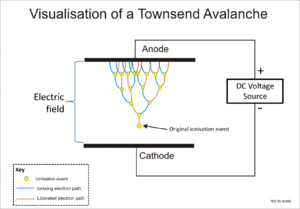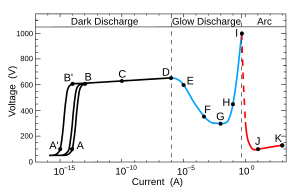利用者:加藤勝憲/気体放電
気体放電(Electric discharge in gases)とは、気体の電離により気体中に放電現象が起こり電流が流れること。いくつかの要因によって、放電は可視光を放射することがある。気体中の放電の特性は、照明光源の設計や高電圧電気機器の設計に関連して研究されている。
放電の種類
[編集]


冷陰極管では、ガス中の放電は3つの領域があり、それぞれ異なる電流-電圧特性を持つ[1]。
In cold cathode tubes, the electric discharge in gas has three regions, with distinct current–voltage characteristics:[1]
- I:タウンゼント放電、絶縁破壊電圧以下。低電圧では、宇宙線やその他の電離放射線源によってガス中に電荷キャリアが生成されることによる電流のみである。印加電圧を上げると、電流を運ぶ自由電子が十分なエネルギーを得てさらにイオン化し、電子なだれを起こす。この領域では、電流はフェムトアンペアからマイクロアンペアに、つまり9桁も増加するが、電圧はほとんど増加しない。電圧-電流特性は降伏電圧付近で先細りし始め、グローが見えるようになる。 I: Townsend discharge, below the breakdown voltage. At low voltages, the only current is that due to the generation of charge carriers in the gas by cosmic rays or other sources of ionizing radiation. As the applied voltage is increased, the free electrons carrying the current gain enough energy to cause further ionization, causing an electron avalanche. In this regime, the current increases from femtoamperes to microamperes, i.e. by nine orders of magnitude, for very little further increase in voltage. The voltage-current characteristics begins tapering off near the breakdown voltage and the glow becomes visible.
- II:グロー放電:降伏電圧に達すると発生する。電極間の電圧は突然低下し、電流はミリアンペアの範囲まで増加する。より低い電流では、管を横切る電圧はほとんど電流に依存しない。これはグロー放電電圧調整管で使用される。低電流では、グロー放電で覆われる電極の面積は電流に比例する。より高い電流では、正常なグローは異常なグローに変わり、管全体の電圧は徐々に上昇し、グロー放電は電極の表面をより多く覆うようになります。低電力スイッチング(グロー放電サイロトロン)、電圧安定化、照明アプリケーション(ニキシー管、デカトロン、ネオンランプなど)はこの領域で動作します。II: glow discharge, which occurs once the breakdown voltage is reached. The voltage across the electrodes suddenly drops and the current increases to milliampere range. At lower currents, the voltage across the tube is almost current-independent; this is used in glow discharge voltage-regulator tubes. At lower currents, the area of the electrodes covered by the glow discharge is proportional to the current. At higher currents the normal glow turns into abnormal glow, the voltage across the tube gradually increases, and the glow discharge covers more and more of the surface of the electrodes. Low-power switching (glow-discharge thyratrons), voltage stabilization, and lighting applications (e.g. Nixie tubes, decatrons, neon lamps) operate in this region.
- III:電流のアンペア範囲で発生するアーク放電。電流が増加するにつれて管全体の電圧は低下する。大電流スイッチング管、例えばトリガー式スパークギャップ、イグニトロン、サイラトロン、クライトロン(および真空アークを使用する真空管の派生品であるスプライトロン)、高出力水銀アークバルブ、高出力光源、例えば水銀蒸気ランプやメタルハライドランプは、この範囲で動作する。 III: arc discharge, which occurs in the ampere range of the current; the voltage across the tube drops with increasing current. High-current switching tubes, e.g. triggered spark gap, ignitron, thyratron and krytron (and its vacuum tube derivate, sprytron, using vacuum arc), high-power mercury-arc valves and high-power light sources, e.g. mercury-vapor lamps and metal halide lamps, operate in this range.
グロー放電は、電子がガス原子に衝突して電離することによって促進される。グロー放電の形成には、電子の平均自由行程が電極間の距離よりも短く、適度に長くなければならない。したがって、グロー放電は、ガス圧が低すぎても高すぎても起こりにくい。
Glow discharge is facilitated by electrons striking the gas atoms and ionizing them. For formation of glow discharge, the mean free path of the electrons has to be reasonably long but shorter than the distance between the electrodes; glow discharges therefore do not readily occur at both too low and too high gas pressures.
グロー放電の絶縁破壊電圧は、パッシェンの法則に従い、ガス圧力と電極距離の積に非線形に依存する。ある圧力×距離の値に対して、最も低い絶縁破壊電圧が存在する。電極距離が短いほど電圧が高くなるのは、電極距離に比べて電子の平均自由行程が長すぎるためである。
The breakdown voltage for the glow discharge depends nonlinearly on the product of gas pressure and electrode distance according to Paschen's law. For a certain pressure × distance value, there is a lowest breakdown voltage. The increase of strike voltage for shorter electrode distances is related to too long mean free path of the electrons in comparison with the electrode distance.
少量の放射性元素を、別個の材料として(例えば、クリトロンのニッケル-63)、あるいは電極の合金に添加して(例えば、トリウム)、管内に添加し、ガスを予備電離させ、電気絶縁破壊とグロー放電またはアーク放電点火の信頼性を高めることができる。気体の放射性同位元素、例えばクリプトン-85を使用することもできる。点火電極や維持放電電極も採用できる[2]。
A small amount of a radioactive element may be added into the tube, either as a separate piece of material (e.g. nickel-63 in krytrons) or as addition to the alloy of the electrodes (e.g. thorium), to preionize the gas and increase the reliability of electrical breakdown and glow or arc discharge ignition. A gaseous radioactive isotope, e.g. krypton-85, can also be used. Ignition electrodes and keepalive discharge electrodes can also be employed.[2]
電子の平均エネルギー(したがって放電の他の多くの特性)はE/Nの関数であるため、電界Eと中性粒子濃度Nの間のE/N比がしばしば使用される。ある係数qだけ電界強度Eを増加させることは、係数qだけガス密度Nを低下させることと同じ結果をもたらす。
The E/N ratio between the electric field E and the concentration of neutral particles N is often used, because the mean energy of electrons (and therefore many other properties of discharge) is a function of E/N. Increasing the electric intensity E by some factor q has the same consequences as lowering gas density N by factor q.
SI単位はV・cm2であるが、タウンゼント単位(Td)がよく使われる。
Its SI unit is V·cm2, but the Townsend unit (Td) is frequently used.
アナログ・コンピューティング・アプローチを提供
[編集]この研究を紹介した『ネイチャー』誌のニュース記事[4]によると、インペリアル・カレッジ・ロンドンの研究者たちは、観光客に発光するルート案内を提供するミニマップの作り方を実演した。1インチのロンドン・チップを作るために、研究チームはスライドガラスにロンドン中心部の平面図をエッチングした。その上に平らな蓋をかぶせると、通りは中空のつながったチューブになった。これをヘリウムガスで満たし、観光の要所に電極を挿入した。 2点間に電圧をかけると、電気がAからBへの最短ルートに沿って通りを自然に走り、ガスが小さなストリップライトのように光る。このアプローチ自体は、マイクロ流体チップ内のグロー放電の点灯特性に基づいて、幅広いクラスの迷路探索問題を解くための新しい可視アナログ・コンピューティング・アプローチを提供する。
The use of a glow discharge for solution of certain mapping problems was described in 2002. [3] According to a Nature news article describing the work,[4] researchers at Imperial College London demonstrated how they built a mini-map that gives tourists luminous route indicators. To make the one-inch London chip, the team etched a plan of the city centre on a glass slide. Fitting a flat lid over the top turned the streets into hollow, connected tubes. They filled these with helium gas, and inserted electrodes at key tourist hubs. When a voltage is applied between two points, electricity naturally runs through the streets along the shortest route from A to B – and the gas glows like a tiny glowing strip light. The approach itself provides a novel visible analog computing approach for solving a wide class of maze searching problems based on the properties of lighting up of a glow discharge in a microfluidic chip.
References
[編集]- ^ Reference Data for Engineers: Radio, Electronics, Computers and Communications By Wendy Middleton, Mac E. Van Valkenburg, p. 16-42, Newnes, 2002 ISBN 0-7506-7291-9
- ^ Handbook of optoelectronics, Volume 1 by John Dakin, Robert G. W. Brown, p. 52, CRC Press, 2006 ISBN 0-7503-0646-7
- ^ Reyes, D. R.; Ghanem, M. M.; Whitesides, G. M.; Manz, A. (2002). “Glow discharge in microfluidic chips for visible analog computing”. Lab on a Chip 2 (2): 113–6. doi:10.1039/B200589A. PMID 15100843.
- ^ “Glow discharge in microfluidic chips for visible analog computing”. Nature. (27 May 2002). doi:10.1038/news020520-12.
[[Category:未査読の翻訳があるページ]]
